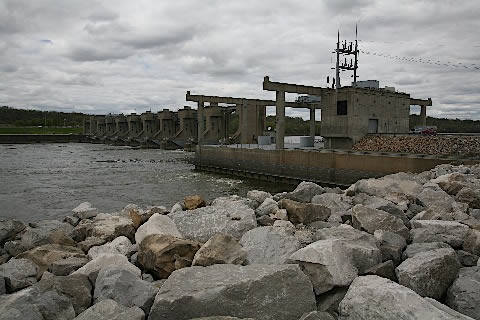 Retrofitting dams to generate electricityAug 19, 2009 - Kate Galbraith - The New York Times
Environmental opposition often means that new hydropower facilities are non-starters. But there may be a way around that: retrofitting existing dams. Only 3 percent of the 80,000 dams in the United States are used to generate power, according to Norm Bishop, a vice president at MWH, a water engineering firm. They were built for other purposes, like flood control, recreation, irrigation or water storage. To expand the nation’s hydropower capacity, “We should be looking at the dams in the 97 percent range that have no existing power facilities,” Mr. Bishop said. One such effort is happening along the Ohio River. American Municipal Power, a large power supplier based in Ohio that is working with MWH, broke ground earlier this month on the first of five planned hydropower retrofit projects on the river. The total cost will come to around $1.9 billion, according to Marc Gerken, A.M.P.’s chief executive, and the projects should be completed between 2013 and 2015. Total power production will be 350 megawatts, enough to supply 350,000 homes. “These powerhouses will last 70 years,” Mr. Gerken said. “Once you construct them, and once debt service is done, you basically have free fuel.”
He cited renewable energy and climate policies as part of the motivation for retrofitting the dams, which would be a clean source of power. Carbon regulation is “coming, and you’d better manage your carbon footprint,” he said. A Sierra Club representative in Ohio said that he fully backed A.M.P.’s project. “Retrofitting dams to produce hydropower can displace dirty energy from the grid,” said Nachy Kanfer, who is with the group’s Beyond Coal Campaign. “There’s really nothing to dislike with this proposal.” The existing dams along the Ohio River were built in the 1950s and 1960s, for navigation and watershed purposes, according to Mr. Gerken. A.M.P. also retrofitted the Belleville Dam, along the Ohio River in West Virginia, in 1999. Getting a license from the Army Corps of Engineers, which operates the dams, tends to be a painstaking, multiyear process, according to Mr. Gerken. “I had envisioned starting all of these projects six months ago, and obviously I only got one started,” he said. Another power developer, Brookfield Renewable Power, has a retrofit project under construction on the Mississippi River in Minnesota. That project would add 10 megawatts of power capacity to an existing Army Corps dam. This 2007 federal survey of hydropower capabilities identifies other dams that with retrofit potential. Asked about whether he had received money from the stimulus package for the projects, Mr. Gerken of A.M.P. responded that he had gotten “not one red nickel.” “What’s really ironic to me,” he added, “is how hydro has just totally fallen under the radar screen” in terms of incentives, relative to wind and solar. |
Updated: 2003/07/28
